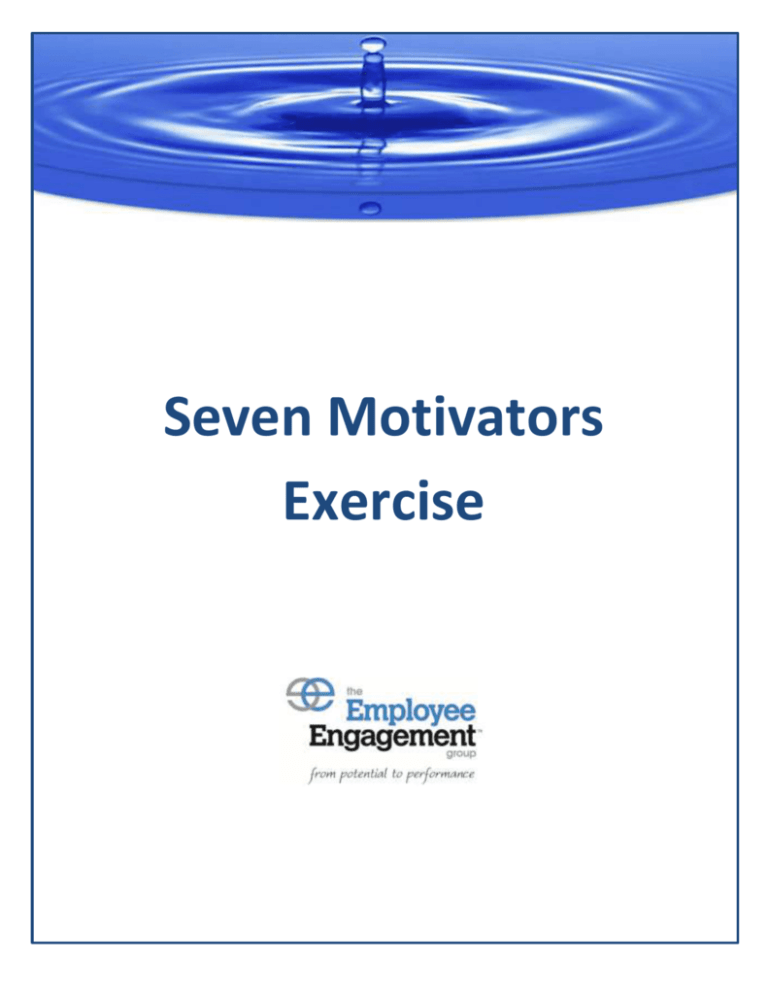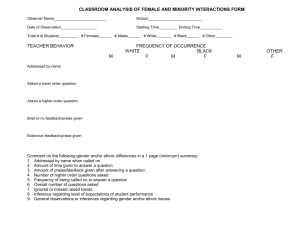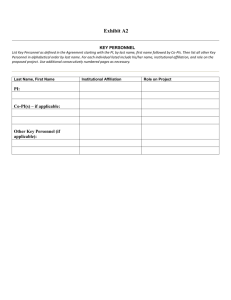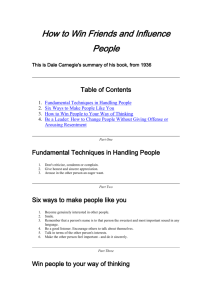
Seven Motivators
Exercise
Seven Motivators
Description
Employees with this need want the
satisfaction of accomplishing projects
successfully. They want to exercise
their talents to attain success. They are
self-motivated if the job is challenging
enough.
Might be heard saying
“I’d like to take on more
responsibility.”
Actions to meet needs
Assign challenging task
that stretch their skills
The ‘right’ assignment is
essential
Authority
These employees get satisfaction from
influencing and sometimes even
controlling others. They like to lead and
persuade, and are motivated by
positions of power and leadership.
“Bob, you take this
task. Jim, you
complete task #2. Send
me an e0mail at the end
of each day with your
progress.”
Provide the chance to
lead and make decisions
Assign a mentor
Affiliation
This need is satisfied through affiliation
with others. These employees enjoy
people and find the social aspect of the
workplace rewarding.
“Let’s get the team
together to talk about
next steps.”
Opportunities to work in
teams, organize meetings,
and conduct brainstorm
sessions
Autonomy
These employees want freedom and
independence. They like to work and
take responsibility for their own
tasks/projects
“I’ll take this task and
report progress in two
weeks.”
Allow to set own schedule
and work independently
Esteem
These employees need sincere
recognition and praise. They dislike
generalities – praise specific
accomplishments. This does not
necessarily mean public praise.
“Would you take a look
at this and tell me how
it looks?”
Recognize and praise
often, both privately and
in public (if appropriate)
Safety/
Security
Employees with this motivation crave job
security, a steady income, health
insurance, other fringe benefits, and a
hazard-free work environment.
“How does that impact
my job?”
Equity
These employees what to be treated
fairly. They probably compare work
hours, job duties, salary, and privileges
to those of other employees. They will
become discouraged if they perceive
inequities.
“Betty always seems to
get the good
assignments and I get
the ones with all the
problems.”
Clear cut work
assignments
Discussion of
assignments after current
one is complete
Address equity issues
immediately
Answer the questions that
are asked honestly
Demonstrate fair
treatment
Achievement
otivators adapted from The Manager’s Desk Reference by Cynthia Berryman-Fink and Charles B. Fink
© The Employee Engagement Group
All Rights Reserved
1
Motivation Team Assessment
List the members of your staff/team (including yourself) and identify what you think are the primary and
secondary motivators for each person. Make a list of ideas to better engage each team member base on
his/her primary and secondary motivational drivers.
As a follow-up, you might ask your team to complete the Motivation Self-Assessment and compare your
answers to theirs.
Motivation
Achievement
Authority
Affiliation
Autonomy
Esteem
Safety and
Security
Equity
Description
Employees with this need want the satisfaction of accomplishing projects successfully. They want
to exercise their talents to attain success. They are self-motivated if the job is challenging
enough.
These employees get satisfaction from influencing and sometimes even controlling others. They
like to lead and persuade, and are motivated by positions of power and leadership.
This need is satisfied through affiliation with others. These employees enjoy people and find the
social aspect of the workplace rewarding.
These employees want freedom and independence. They like to work and take responsibility for
their own tasks/projects
These employees need sincere recognition and praise. They dislike generalities – praise specific
accomplishments. This does not necessarily mean public praise.
Employees with this motivation crave job security, a steady income, health insurance, other fringe
benefits, and a hazard-free work environment.
These employees what to be treated fairly. They probably compare work hours, job duties, salary,
and privileges to those of other employees. They will become discouraged if they perceive
inequities.
Adapted from The Manager’s Desk Reference by Cynthia Berryman-Fink and Charles B. Fink
Name
Primary and one
secondary motivator
Ideas to better engage this employee
Your Name
© The Employee Engagement Group
All Rights Reserved
2
Name
Primary and one
secondary motivator
© The Employee Engagement Group
All Rights Reserved
Ideas to better engage this employee
3
Motivation Self-Assessment
In the boxes beside each motivation, place the numbers 1 – 7 using each number only once.
#1 = your primary motivational driver
#7 = what motivates you the least
Be sure to use all seven numbers. After you’ve ranked yourself, write some ideas that would motivate
each of the seven motivators.
Motivation
Achievement
Authority
Affiliation
Autonomy
Esteem
Security
Equity
Need
Ideas for Success
Employees with this need want the satisfaction of
accomplishing projects successfully. They want
to exercise their talents to attain success. They
are self-motivated if the job is challenging enough,
so provide them with the right work assignments
and they will consistently produce
These employees get satisfaction from influencing
and sometimes even controlling others. They like
to lead and persuade, and are motivated by
positions of power and leadership. Give them the
opportunity to make decisions and direct projects
This need is satisfied through affiliation with
others. These employees enjoy people and find
the social aspect of the workplace rewarding.
Motivate them by giving them opportunities to
interact with others: teamwork projects, group
meetings, and so on.
These employees want freedom and
independence. Allow them to make their own
choices, set their own schedules, and work
independently of others.
These employees need recognition and praise.
This does not necessarily mean public praise.
Give them ample feedback and recognition
whenever possible.
Employees with this motivation crave job security,
a steady income, health insurance, and a hazardfree work environment. These folks need
predictable work with little risk or uncertainty.
Salary and fringe benefits are also important to
them.
These employees what to be treated fairly. They
probably compare work hours, job duties, salary,
and privileges to those of other employees. They
will become discouraged if they perceive
inequities.
© The Employee Engagement Group
All Rights Reserved
4








